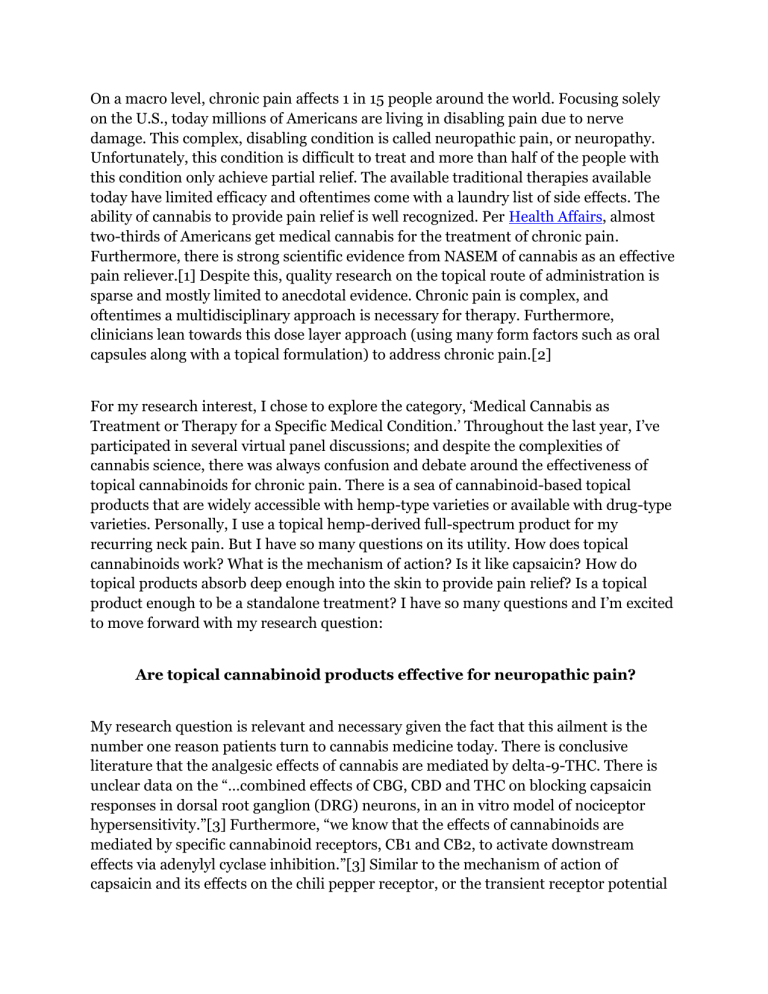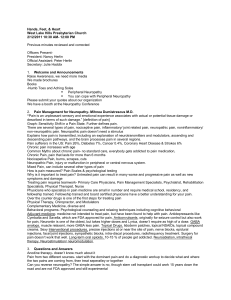
On a macro level, chronic pain affects 1 in 15 people around the world. Focusing solely on the U.S., today millions of Americans are living in disabling pain due to nerve damage. This complex, disabling condition is called neuropathic pain, or neuropathy. Unfortunately, this condition is difficult to treat and more than half of the people with this condition only achieve partial relief. The available traditional therapies available today have limited efficacy and oftentimes come with a laundry list of side effects. The ability of cannabis to provide pain relief is well recognized. Per Health Affairs, almost two-thirds of Americans get medical cannabis for the treatment of chronic pain. Furthermore, there is strong scientific evidence from NASEM of cannabis as an effective pain reliever.[1] Despite this, quality research on the topical route of administration is sparse and mostly limited to anecdotal evidence. Chronic pain is complex, and oftentimes a multidisciplinary approach is necessary for therapy. Furthermore, clinicians lean towards this dose layer approach (using many form factors such as oral capsules along with a topical formulation) to address chronic pain.[2] For my research interest, I chose to explore the category, ‘Medical Cannabis as Treatment or Therapy for a Specific Medical Condition.’ Throughout the last year, I’ve participated in several virtual panel discussions; and despite the complexities of cannabis science, there was always confusion and debate around the effectiveness of topical cannabinoids for chronic pain. There is a sea of cannabinoid-based topical products that are widely accessible with hemp-type varieties or available with drug-type varieties. Personally, I use a topical hemp-derived full-spectrum product for my recurring neck pain. But I have so many questions on its utility. How does topical cannabinoids work? What is the mechanism of action? Is it like capsaicin? How do topical products absorb deep enough into the skin to provide pain relief? Is a topical product enough to be a standalone treatment? I have so many questions and I’m excited to move forward with my research question: Are topical cannabinoid products effective for neuropathic pain? My research question is relevant and necessary given the fact that this ailment is the number one reason patients turn to cannabis medicine today. There is conclusive literature that the analgesic effects of cannabis are mediated by delta-9-THC. There is unclear data on the “…combined effects of CBG, CBD and THC on blocking capsaicin responses in dorsal root ganglion (DRG) neurons, in an in vitro model of nociceptor hypersensitivity.”[3] Furthermore, “we know that the effects of cannabinoids are mediated by specific cannabinoid receptors, CB1 and CB2, to activate downstream effects via adenylyl cyclase inhibition.”[3] Similar to the mechanism of action of capsaicin and its effects on the chili pepper receptor, or the transient receptor potential channel vanilloid type 1 (TRPV1), there is evidence for CBD and CBG interaction on that receptor as well. Interestingly, “TRPV1 are expressed in small sensory neurons of the DRG and detects noxious stimuli such as temperature of 43c and above, inflammatory mediators, low pH, and capsaicin, the pungent ingredient of chili peppers.” [3] There are several studies suggesting that capsaicin may be a potential therapy for neuropathic pain. If cannabinoids influence the same receptor, then we can assume that cannabinoids can also help with nerve pain. [3,4] Our research will validate this assumption and will also delve into the largest organ in the body, the skin and the barriers of entry using topical routes of formulation. To conduct my literature review, I used the following search terms: Cannabis and pain (or cannabinoids and pain); Cannabis and chronic pain (or cannabinoids and chronic pain); Cannabis and neuropathic pain (or cannabis and neuropathic pain); Cannabinoids and neuropathic pain (or cannabinoids and neuropathy); Topical cannabis and neuropathic pain (or topical cannabinoids and neuropathic pain). I started my search terms broadly and progressively started narrowing in by specifying the type of chronic pain - neuropathic pain. I refined my search even more with filters article type (rcts; systematic review and/or meta-analysis) and publication date (<10 years). I also played around with additional filters, like the age refinement box - selected “middle-aged +”. I noticed the research results were dwindling with increasing specificity and was only left with 3 results (shown below). This ultimately was not going to work so I reverted backwards to loosen up my refinement process. I outlined my research topic using the FINER criteria. Starting with feasibility, I would look for an adequate number of subjects to increase the validity of my study. I believe a prospective observational study methodology is more sensible than RCTs with its scope and affordability (time and money) so that’s how I would proceed in design. My research question applies to real-world applications today and I hope the findings will confirm and extend previous findings. To date, there is no quality research solely looking at topical cannabinoids for neuropathic pain in a large sample size with a prospective observational framework. The new findings in this study will build up the empirical literature on topical cannabinoid-based products and its utility for pain management. In turn, I hope it would influence directions for future research and have significant impacts on scientific knowledge, clinical practice, and health policy. References: [1] National Academies of Sciences E and M, Health and Medicine Division, Board on Population Health and Public Health Practice, Committee on the Health Effects of Marijuana: An Evidence Review and Research Agenda. The Health Effects of Cannabis and Cannabinoids: The Current State of Evidence and Recommendations for Research. Washington, DC: National Academies Press; 2017. [2] Jean-Jacques J, Cook R, Winterstein AG, et al. Priorities for Medical Marijuana Research from the Perspective of Physicians, Dispensary Owners/Staff, and Patients: A Survey Study. Med Cannabis Cannabinoids. 2021;4(2):107-113. Published 2021 Aug 2. [3] Sultana A, Singla RK, He X, Sun Y, Alam MS, Shen B. Topical Capsaicin for the Treatment of Neuropathic Pain. Curr Drug Metab. 2021;22(3):198-207. [4] Anand U, Oldfield C, Pacchetti B, Anand P, Sodergren MH. Dose-Related Inhibition of Capsaicin Responses by Cannabinoids CBG, CBD, THC and their Combination in Cultured Sensory Neurons. J Pain Res. 2021;14:3603-3614. Published 2021 Nov 24.




